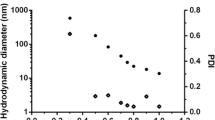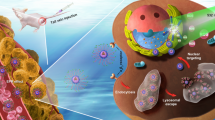Abstract
Blue light emitting diode (BLED) were known to inhibit cancer proliferation and induced apoptotic cell death by increasing intracellular reactive oxygen species (ROS) and caspase activation. However, not many attempts were made to study the naturally occurring photosensitizer molecule (PS) curcuminoids (CUR) mediated blue light emitting diode induced photodynamic therapy (BLED-PDT). Here, we demonstrated the use of pluronic F127 nanoplatform as a novel BLED-PDT based system for anticancer therapy. Aqueous soluble F127-CUR was proven to significantly mediate BLED-PDT, we anticipate that F127-CUR combined with BLED to induce BLED-PDT could be a promising cancer treatment modality.

Similar content being viewed by others
References
Nat. Chem. Biol, 10, 483 (2014).
P.-S. Oh, H. Hwang, H.-S. Jeong, J. Kwon, H.-S. Kim, M. Kim, S. Lim, M.-H. Sohn, and H.-J. Jeong, Data Brief, 6, 630 (2016).
J. N. Lundström, S. Boesveldt, and J. Albrecht, ACS Chem. Neurosci., 2, 5 (2011).
N. Tharmalingam, J. Port, D. Castillo, and E. Mylonakis, Sci. Rep., 8, 3701 (2018).
N. Tharmalingam, M. Park, M. H. Lee, H. J. Woo, H. W. Kim, J. Y. Yang, K.-J. Rhee, and J.-B. Kim, Am. J. Transl. Res., 8, 885 (2016).
K. M. Nelson, J. L. Dahlin, J. Bisson, J. Graham, G. F. Pauli, and M. A. Walters, J. Med. Chem., 60, 1620 (2017).
J. V. Crivello and U. Bulut, J. Polym. Sci. A: Polym. Chem., 43, 5217 (2005).
H. Kitano, Advances In Light-induced Polymerizations: I. Shadow Cure in Free Radical Photopolymerizations, II. Experimental and Modeling Studies of Photoinitiator Systems for Effective Polymerizations with LEDs, Doctor of Philosophy Thesis, University of Iowa, 2012.
J. V. Crivello, J. Polym. Sci. A: Polym Chem., 47, 1825 (2009).
E. Burgos-Morón, J. M. Calderón-Montaño, J. Salvador, A. Robles, and M. López-Lázaro, Int. J. Cancer., 126, 1771 (2010).
C. Santezi, B. D. Reina, and L. N. Dovigo, Photodiagn. Photodyn., 21, 409 (2018).
A. Pitto-Barry and N. P. E. Barry, Polym. Chem., 5, 3291 (2014).
S. V. Berwin Singh, J. Kim, H. Park, G. Khang, and D. Lee, Macromol. Res., 25, 749 (2017).
S. V. Berwin Singh, E. Jung, J. Noh, D. Yoo, C. Kang, H. Hyeon, G.-W. Kim, G. Khang, and D. Lee, Nanomedicine, 16, 45 (2019).
S. V. Berwin Singh, H. Park, G. Khang, and D. Lee, Macromol. Res., 26, 40 (2018).
L. M. Huong, D. H. Doan, T. H. H. Tran, D. L. Vu, N. H. Nam, T. H. N. Tran, N. L. Dinh, H. C. Kim, L. H. Cuong, T. T. H. Le, T. H. Trung, and H. P. Thu, Adv. Nat. Sci. Nanosci., 7, 045019 (2016).
D. P. Bhopate, P. G. Mahajan, K. M. Garadkar, G. B. Kolekar, and S. R. Patil, New J. Chem., 39, 7086 (2015).
K. Park and J. H. Lee, Oncol. Rep., 17, 537 (2007).
W. H. Chan and H. J. Wu, J. Cell Biochem., 92, 200 (2004).
Author information
Authors and Affiliations
Corresponding author
Additional information
Publisher’s Note Springer Nature remains neutral with regard to jurisdictional claims in published maps and institutional affiliations.
Acknowledgment: This work was supported by Brain Korea 21+ project in 2018. This work was also supported by Radiation Technology R&D program 2016M2A2A7A03912640 through the National Research Foundation of Korea funded by the Ministry of Science ICT & Future Planning and from the Korea Health Industry Development Institute (KHIDI), funded by the Ministry of Health & Welfare, Korea (grant number: HI18C0139). The authors are thankful to CURF, Chonbuk National University, South Korea for TEM analysis.
Rights and permissions
About this article
Cite this article
Vetha, B.S.S., Kim, EM., Oh, PS. et al. Curcumin Encapsulated Micellar Nanoplatform for Blue Light Emitting Diode Induced Apoptosis as a New Class of Cancer Therapy. Macromol. Res. 27, 1179–1184 (2019). https://doi.org/10.1007/s13233-019-7168-3
Received:
Revised:
Accepted:
Published:
Issue Date:
DOI: https://doi.org/10.1007/s13233-019-7168-3




